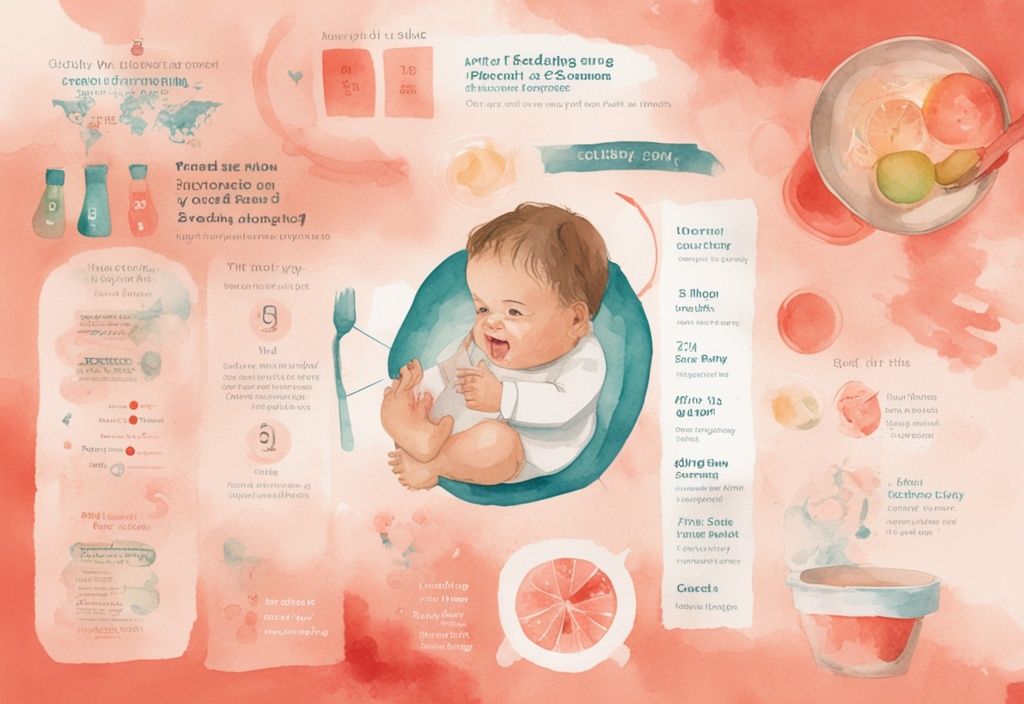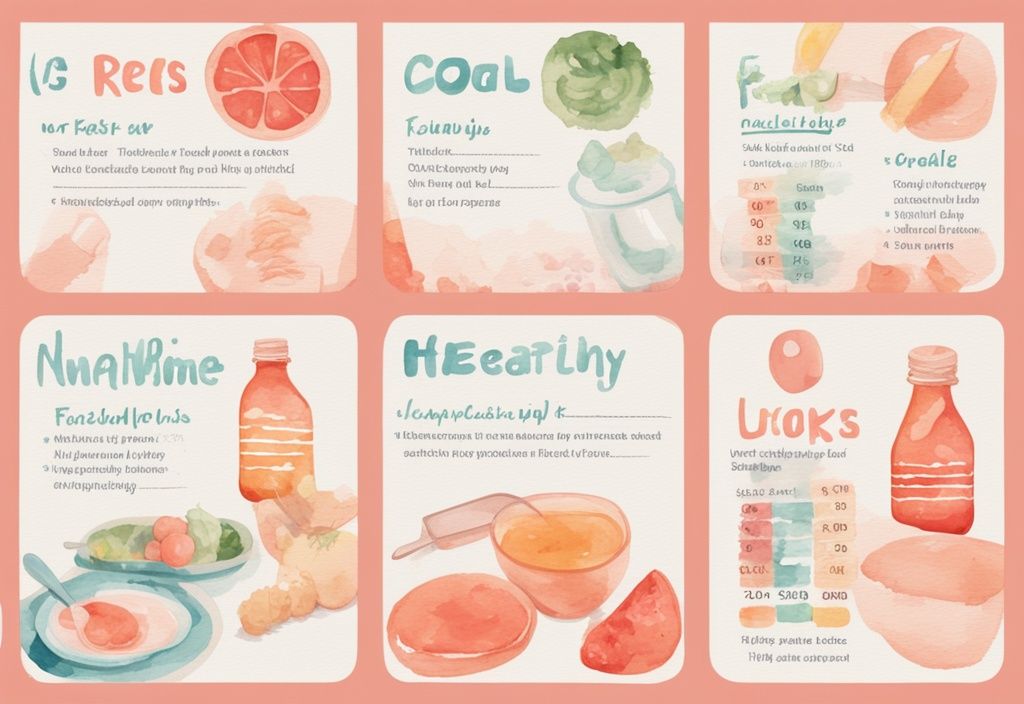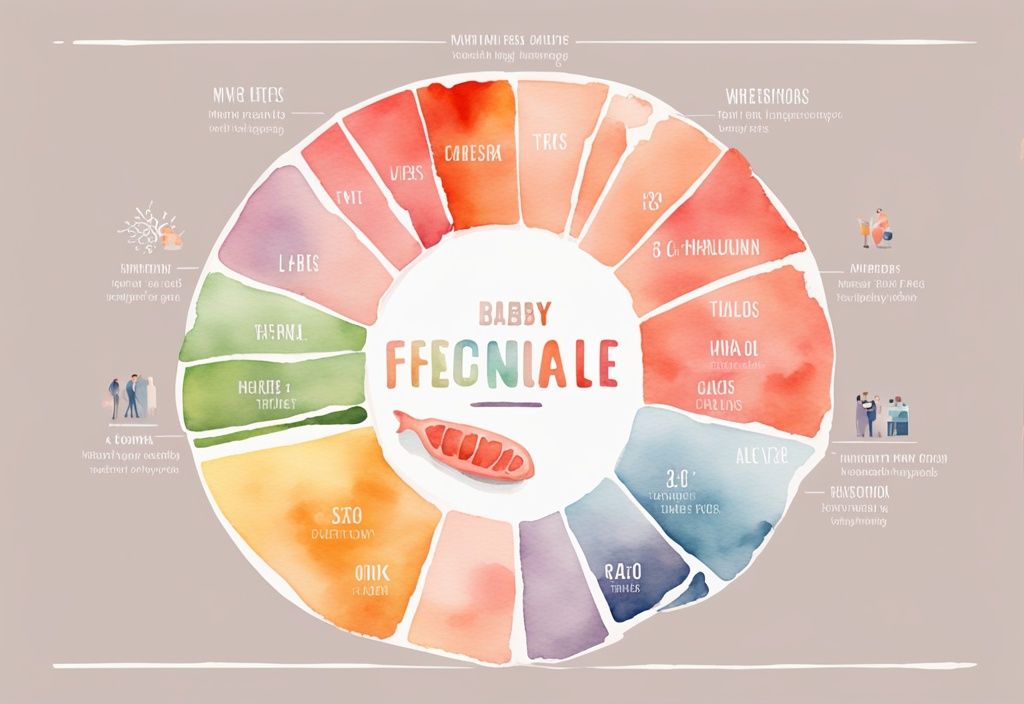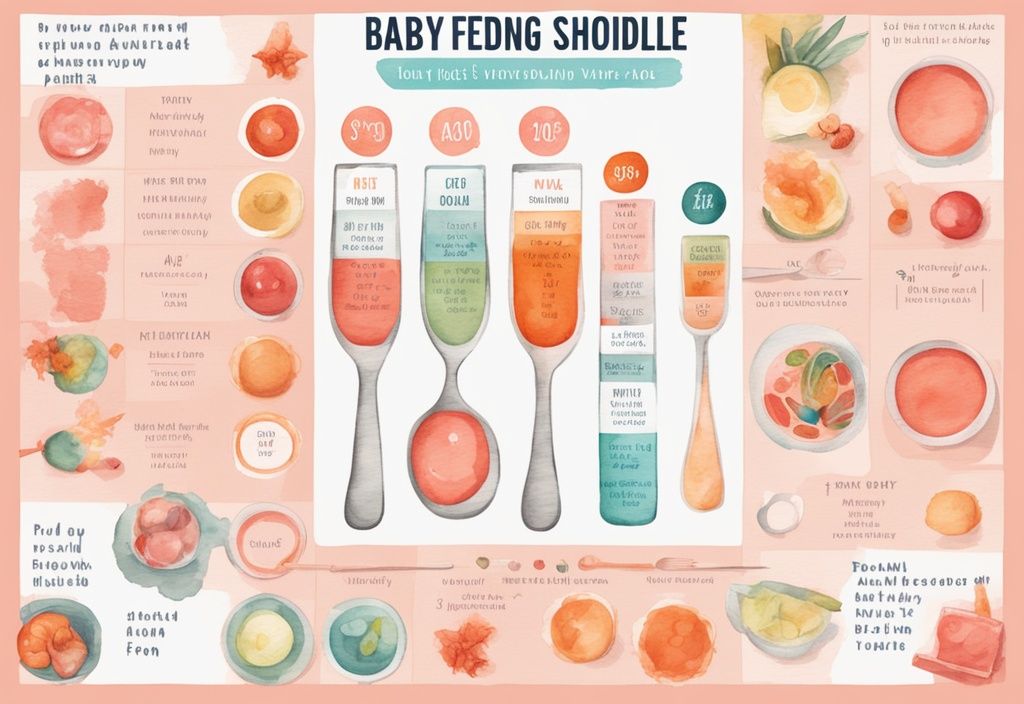Ever wondered if there’s a roadmap to your baby’s feeding journey? As a mom of two, I’ve been there, and I know how overwhelming it can be. That’s why I’ve put together this comprehensive guide to baby feeding schedule by age. It’s a simple, practical resource that takes the guesswork out of feeding your little one.
From recognizing your baby’s hunger cues to introducing solid foods, this guide covers it all. You’ll find age-specific feeding schedules that support your baby’s growth and development, helping you nurture healthy eating habits right from the start.
So, whether you’re a new parent or a seasoned pro, dive in. Let’s navigate this journey together, ensuring your baby gets the nutrition they need at every stage. After all, a well-fed baby is a happy baby, and a happy baby means a happy parent!
Understanding the Importance of a Baby Feeding Schedule
Let’s talk about the magic of a baby feeding schedule by age. It’s like having a trusty map for your baby’s nutrition journey as they grow. This schedule is crucial for making sure your little one gets all the nutrients they need for healthy development. By following a feeding schedule tailored to your baby’s age, you’re setting the stage for lifelong healthy eating habits. It’s about finding that sweet spot between nutritional needs and your baby’s natural hunger cues, and understanding the implications of feeding schedules on both infant well-being and maternal health can provide valuable insights. For a deeper dive into this topic, check out the research available at https://pmc.ncbi.nlm.nih.gov/articles/PMC3553587/.
Now, I know what you might be thinking—schedules can sound rigid. But trust me, a feeding schedule is a wonderful tool for teaching babies when to expect food. This can help them regulate their appetite better, reducing the risks of overeating or undereating as they grow. Plus, having a consistent routine can bring a comforting sense of predictability to both you and your baby, making mealtimes something to look forward to.
But here’s the thing—flexibility is your best friend. Every baby is unique, and their needs might not always fit into a neat little schedule box. It’s important to watch for those individual cues and be ready to tweak the schedule as needed. This adaptability ensures your baby’s nutritional needs are met without turning mealtime into a stress-fest for you.
Ignoring a proper baby feeding schedule by age can lead to some hiccups. Without a structured plan, there’s a risk of malnutrition if your baby doesn’t get enough nutrients, or obesity if they’re overfed. Both can have lasting impacts on their health and development. That’s why understanding and implementing a feeding schedule by age is so important for your little one’s growth and well-being.
Newborn Feeding Schedule (0-1 Month)
In this section, we’ll dive into the essentials of a baby feeding schedule by age for those precious first weeks. From understanding how often to feed your little one to recognizing their subtle cues, let’s explore how to navigate this beautiful, albeit sometimes challenging, phase.
Feeding Frequency and Amounts
Ah, the newborn days! They’re filled with so much wonder and, yes, a lot of feedings. Understanding the baby feeding schedule by age is key to ensuring your newborn is happy and healthy. In the first month, feeding on demand is the way to go. Typically, you’ll find yourself feeding your baby every 2 to 3 hours. In those initial 24 hours, expect them to take in between 2 to 10 milliliters per feeding. It’s amazing how quickly they grow! By 24 to 48 hours old, their intake usually increases to 5 to 15 milliliters. Fast forward to day three, and you might see them consuming about 1 ounce per feeding.
By the end of the first week, your little one will likely be taking in 1 to 2 ounces per feeding, which adds up to about 10 to 20 ounces daily. Between the second and third weeks, you’ll notice an increase to 2 to 3 ounces per feeding, totaling 15 to 25 ounces a day. And by the time that first month wraps up, they typically need at least 4 ounces per feeding. It’s a whirlwind, but watching your baby grow and thrive is so rewarding!
Recognizing Hunger and Fullness Cues
Trust me, recognizing your newborn’s hunger and fullness cues is a game-changer in following a baby feeding schedule by age. Hunger cues can be as simple as your baby putting their hands to their mouth, opening their mouth, or even sucking on their hands. You might also notice a little excitement when food is near—it’s adorable!
On the flip side, fullness cues are just as important. These include closing their mouth, relaxing their hands, or turning their head away from food. It’s all about tuning into these signals rather than sticking to a rigid schedule. This way, you’re meeting your baby’s needs with love and understanding. Remember, you’re doing an amazing job, and every day is a new adventure in this parenting journey!
Baby Feeding Schedule for 1-2 Months
Changes in Feeding Patterns
Ah, those precious early months! A baby’s feeding schedule by age can feel like a whirlwind of changes. As your little one transitions from those initial newborn days, you’ll notice their feeding patterns evolving. By the time they hit the two-week mark, most babies are ready to up their intake to about 2 to 3 ounces per feeding. This change is so important as it matches their growing nutritional needs and ensures they get all the nourishment they need to thrive.

As you inch closer to the two-month milestone, things start to settle into a more predictable rhythm. Babies at this stage usually enjoy 4 to 5 ounces of milk every three to four hours, which typically means around 6 to 8 feedings a day. It’s fascinating how this increase in milk per feed comes with fewer feedings, giving you both a little more breathing room between sessions. This natural progression in a baby feeding schedule by age is a beautiful testament to how your baby’s capacity to enjoy more milk in one go is developing.
From 1 to 3 months, you might notice your baby’s appetite growing even more. This is a time for finding that sweet spot in their feeding routine to ensure they’re getting just the right amount of nutrition. Keep an eye on those hunger cues and be ready to tweak the feeding schedule as needed. By staying flexible yet consistent, you can support your baby’s growth and development during this exciting stage. Remember, you’re doing an amazing job, and every feed is a step towards nurturing your little one’s journey.
Feeding Schedule for 3-4 Month Old Babies
As your little bundle of joy hits the 3 to 4-month mark, their baby feeding schedule by age becomes a crucial part of their growth journey. At this stage, the focus is still on milk, with solid foods typically making their debut around 6 months. Yet, understanding the feeding patterns now is key to supporting your baby’s nutritional needs and development.
Introduction to Solid Foods
Let’s chat about those early days when your baby is still mastering the art of feeding. At 3 months, breastfed babies often nurse 6 to 8 times a day. Yes, it feels like you’re constantly feeding, but this frequency is essential for their rapid growth and nutrition. For formula-fed babies, you’re looking at about 5 ounces per feeding. This ensures they’re getting the nourishment they need to thrive.
As your baby approaches 4 months, you might notice a slight shift in their feeding habits. They generally start consuming 4 to 6 ounces per feeding, with the frequency remaining around 6 to 8 times daily. This gradual increase matches their growing appetite and energy needs, which is both exciting and a little exhausting, right?
Even though solid foods are still a couple of months away, it’s wise to keep an eye on your baby’s readiness. Every baby is unique, and some might show interest in food sooner. If your little one is eyeing your dinner plate or can sit up with some support, these are signs they might be gearing up for solids. Trust your instincts and watch for these cues to make the transition smoother when the time comes.
Feeding Schedule for 5-6 Month Old Babies
As your little one reaches the 5 to 6-month mark, their baby feeding schedule by age starts to shift, introducing an exciting new phase in their development. This period is all about exploring new tastes and textures, setting the foundation for a diverse diet.
Introducing Protein-Rich Foods
Now, let’s talk about protein-rich foods. At this stage, it’s a great idea to start incorporating pureed meats and beans into your baby’s meals. These foods are packed with nutrients that are crucial for their growth and development. Plus, they add a new dimension to your baby’s diet, complementing their nutritional needs perfectly.
By the time babies hit around 6 months, they’re usually ready to dive into the world of solid foods. This exciting transition often includes single-grain cereals, pureed vegetables, and fruits. But don’t worry, breast milk or formula—about 32 ounces a day—still plays a big role in their diet. Remember to introduce new foods slowly and in small amounts. This way, you can keep an eye out for any potential allergies or tummy troubles.
Spotting signs that your baby is ready for solids is key. Look for cues like their ability to grab objects, good head and neck control, and the disappearance of the tongue-thrust reflex. These milestones are your baby’s way of saying, “I’m ready to try something new!” It’s all about paving the way for a varied and balanced diet.
Incorporating these changes into your baby feeding schedule by age ensures they get the nutrients they need for healthy growth. Remember, every baby is unique, so tailor their feeding schedule to fit their individual needs. And don’t hesitate to chat with healthcare providers for personalized advice. You’re doing great, and your baby is lucky to have you guiding them through these new adventures!
Baby Feeding Schedule for 7-8 Months
Transition to More Textured Foods
As your little one hits the 7-8 month milestone, the baby feeding schedule by age takes an exciting turn towards more textured foods. It’s a delightful phase where you can start introducing finger foods, which not only enhance motor skills but also encourage self-feeding. At this age, your baby may need up to 32 ounces of breast milk or formula daily. Alongside, you can offer 2 to 4 tablespoons of solid foods per meal, letting them explore new tastes and textures. It’s a bit like watching them discover a whole new world, one bite at a time!

Introducing a variety of foods is key here. Think soft fruits, cooked veggies, and tiny pieces of soft cheese or bread. This not only provides essential nutrients but also helps your baby develop a taste for different flavors. Keep an eye on their reactions to new foods and tweak their diet as needed. It’s all about finding what makes those tiny taste buds dance!
Many parents find joy in baby-led weaning during this stage. It’s a method where babies are encouraged to self-feed with finger foods when they’re ready. This approach supports independence and lets babies regulate their own intake, fostering a healthy relationship with food. Just make sure the foods are safe and manageable to avoid any choking hazards. Remember, it’s all about letting them explore at their own pace.
The shift to more textured foods is a big step in the baby feeding schedule by age. It’s not just about nutrition; it’s a leap in developmental milestones. Embrace this phase with patience and creativity. Offer a variety of foods to support your baby’s evolving needs, and remember, you’re doing an amazing job!
Feeding Schedule for 9-12 Month Old Babies
As your little one grows into the 9 to 12-month age range, their feeding schedule truly starts to blossom. This exciting phase is all about introducing cow’s milk and a delightful variety of solid foods to meet their evolving nutritional needs. The baby feeding schedule by age during this period focuses on a harmonious balance between solid foods and breast milk or formula, supporting your child’s growth and taste exploration.
Introducing Cow’s Milk and Diverse Foods
By now, around half of your baby’s calories should come from solid foods, while the other half is still happily provided by breast milk or formula. This balance is key to nurturing their growing bodies and budding taste preferences. When introducing cow’s milk, take it slow and steady, ensuring it complements rather than completely replaces breast milk or formula.
Between 10 and 12 months, most babies enjoy eating three to four times a day. This schedule not only encourages self-feeding but also lets them dive into new textures and flavors. Offering a variety of foods is like opening up a world of tastes, helping them develop their palate and ensuring they get a wide range of nutrients. As they become little food explorers, they relish the independence and sensory joy of handling different foods.
During this stage, focusing on a diverse diet is crucial. Think fruits, veggies, grains, and proteins. This approach not only meets their nutritional needs but also lays the groundwork for healthy eating habits. Keep an eye on your baby’s hunger and fullness cues to guide the feeding process, ensuring they get just the right amount of nutrition without overfeeding.
Toddler Feeding Schedule (1-2 Years)
Establishing Regular Meals and Snacks
As our little ones grow from babies into curious toddlers, setting up a structured baby feeding schedule by age becomes a wonderful adventure. Between the ages of 1 and 2, these tiny explorers thrive on three regular meals a day, sprinkled with healthy snacks. This routine not only meets their increasing nutritional needs but also encourages them to explore a delightful variety of foods.
After that first birthday bash, most of your toddler’s calories should come from finely chopped table food. It’s a big step from purees to more textured foods, but it’s so important for their developing chewing skills. Plus, it’s a great way to introduce them to family meals. Whole milk, served in a sippy cup, becomes their trusty sidekick, providing around 700 mg of calcium per day. That’s about 2 to 3 cups of milk, though you can also sneak in some calcium through yogurt, cheese, and leafy greens.
Creating a consistent meal and snack schedule is like setting up a cozy routine that supports nutritional intake and brings a sense of predictability. This can be a game-changer in encouraging toddlers to try new foods, as they get used to regular eating times. Offering a variety of foods during these meals can help steer clear of picky eating habits and ensure a balanced diet. As parents, we’re encouraged to offer a range of textures and flavors, promoting healthy eating habits that can last a lifetime. Remember, it’s all about making mealtime fun and stress-free!
Common Challenges in Baby Feeding Schedules
Navigating a baby feeding schedule by age can feel like a rollercoaster ride, full of ups and downs. From picky eating habits to managing food allergies, each stage brings its unique set of challenges. But don’t worry, you’re not alone on this journey. Let’s explore some common hurdles and how to tackle them with grace and patience.
Dealing with Picky Eating
Ah, picky eating—the nemesis of every well-planned baby feeding schedule by age! It’s a phase that many parents encounter, where your little one might suddenly turn up their nose at the carefully prepared peas or carrots. But guess what? It’s perfectly normal! Babies and toddlers often develop strong preferences, and it can feel like you’re in a never-ending battle at mealtime.

Here’s a tip: try offering a variety of foods to keep things interesting. Pairing new foods with familiar favorites can work wonders. Just remember, patience is your best friend here. Forcing them to eat can lead to a whole host of mealtime woes. Instead, make meals a fun and relaxed affair. Sometimes, involving your child in the kitchen can spark their curiosity about new foods. Consistency is key, and with a little persistence, you might just see their palate expand over time.
Managing Food Allergies and Feeding Difficulties
Food allergies and feeding difficulties can certainly throw a wrench in your baby feeding schedule by age. Allergies can be tricky, causing reactions that no parent wants to see. And let’s not forget about those feeding difficulties, like trouble swallowing or aversions to certain textures. It’s enough to make any parent anxious.
But fear not! Teaming up with pediatricians and dietitians can be a game-changer. They can help you pinpoint allergens and suggest safe, nutritious alternatives. For those feeding difficulties, they might have some clever strategies to introduce different textures gradually. Keep those lines of communication open with your healthcare providers. Adjusting the feeding schedule to suit your child’s needs ensures their growth and development stay on track.
FAQ
Welcome to the FAQ section where we dive into common questions about your baby’s feeding journey. From recognizing signs of readiness for solids to understanding how much your little one should eat, this section is here to offer guidance and reassurance.
What are the signs that my baby is ready for solid foods?
Oh, the exciting milestone of starting solids! Look for signs like your baby sitting up with a bit of support, showing curiosity about what’s on your plate, and mastering the art of grabbing. If your little one has good head and neck control and has lost the tongue-thrust reflex, it’s a good indication they might be ready to explore the world of solid foods. Remember, every baby is unique, so trust your instincts and enjoy this new adventure together!
How can I ensure my baby is getting enough nutrition?
Navigating the world of baby nutrition can feel a bit daunting, but you’re not alone. It’s always a great idea to consult with your healthcare provider for personalized advice on baby feeding schedules by age and weaning. Aim for a balanced diet with a variety of nutrients from different food groups. And don’t worry, continuing breastfeeding or formula feeding alongside solids is perfectly normal and often recommended by pediatricians.
When should I introduce water and juice to my baby’s diet?
Introducing water can usually start around the 6-month mark, when your baby begins exploring solid foods. As for juice, it’s best to wait until after their first birthday and even then, keep it limited to maintain a good balance of hydration and nutrition. Remember, every sip is a step in their growing journey!
How do I know if my baby is eating too much or too little?
It’s all about tuning into your baby’s hunger and fullness cues rather than sticking to a rigid schedule. Your little one will let you know when they’ve had enough or need a bit more. Regular check-ups with your pediatrician are a great way to keep track of their growth and ensure they’re getting just the right amount of food for their needs. Trust yourself and your baby—you’re both doing great!
Conclusion
Creating a baby feeding schedule by age is like piecing together a puzzle that ensures your little one gets the nutrition they need to thrive. Each age brings its own set of nutritional needs, and understanding these helps you craft a feeding plan that supports all those adorable milestones.
But let’s be real—guidelines are just that, guidelines. Flexibility is key because every baby is their own little person. Observing your baby’s hunger and fullness cues and adjusting the schedule accordingly keeps them happy and well-fed.
Don’t hesitate to reach out to healthcare providers for advice. Pediatricians and dietitians can offer insights tailored to your baby’s unique needs, helping you navigate challenges like food allergies or feeding difficulties. Their support can be a lifesaver!
In the end, a thoughtfully structured baby feeding schedule by age sets the stage for healthy eating habits that can last a lifetime. It builds a routine that nurtures your baby’s growth and well-being. By embracing a flexible and informed approach, you’re setting the foundation for a lifetime of healthy eating and happy tummies.


